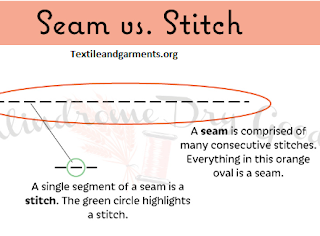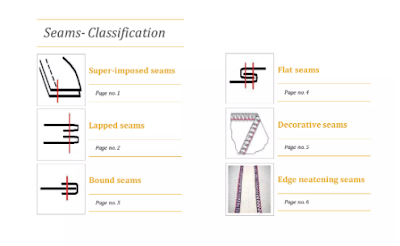Overview of Stitch and Seam and Their Types
Stitch and Seam
The line of sewing of more than one layer of fabric or the line of joining of fabric. It is the process of joining two fabrics together
What is Stitch?
The unit of sewing or seaming is called a stitch
What is Seaming?
The attaching procedure of different components of a garment is called seaming
Properties of Seam or Sewing or Stitching
The following properties are necessary when a seam is performed.
- Strength
- Elasticity
- Durability
- Comfort
Difference Between Seam and Stitch
A seam is what you stitch. Seams are of eight types.
Two (or more) pieces of fabric (or other materials) are joined together to form a seam.
A stitch (the noun) is the loop or knot of thread that joins the two fabrics together in sewing.
To stitch (the verb) means to join the fabric by the act of sewing. Stitches are six types. Stich is the unit of sewing.
Types of Seam
1. Class-1, Superimposed seam
2. Class-2, Lapped seam
3. Class-3, Bound seam
4. Class-4, Flat seam
5. Class-5, Decorative seam
6. Class-6, Edge neatening seam
7. Class-7, Extra item addition seam
8. Class-8, Belt loop making seam
Quality of Seam
A: It should have a proper
[1] Strength
[2] Elasticity
[3] Durability
[4] Security
[5] Comfort, etc
Superimposed Seam
It is a simple joining of two layers of fabric. It may be done by plain m/c over-lock m/c or interlock m/c. these types of seams are used for joining the side seams of shirts, pants, etc.
Lapped Seam
It is the joining of two layers of fabric but after joining two edges the other two edges stay at opposite sides. It is done by 'feed of the arm m/c' this type of seam is used for joining the out seam of Jeans [ pants ] and also used for other purposes.
Bound Seam
It is a joining of two layers of fabric. In this process, one fabric is folded and the other is not. It is done by plain m/c with the folder. This type of seam is used for making genbol of Long sleeves [Shirts ], baby dresses, etc.
Flat Seam
It is the joining of two layers of fabric but one layer is not placed on the other, in the process two layers of fabric are stayed side by side and maintain the gap between the two layers. The two layers are joined by decorative or zig-zag stitches by using zig-zag sewing m/c plain m/c or two-needle double stitching m/c. this type of seam is used for manufacturing ladies' dresses mainly.
Decorative Seam
Edge Neatening Seam
It is the joining of two or more layers of fabric but before joining, the edges are cut first then the edges are joined by over-lock sewing. The process is done by overlock sewing m/c.
Class-7 Seam
This seam is used for joining the Lace, Elastic, etc. with the fabric. Plain m/c or zig-zag stitching m/c are normally used for performing this process.
Class-8 Seam
This process is used for joining two edges but not two layers. The belt loop is the product of this process. Normally two needle chain stitching m/c with folder is used for performing this process or Belt Looping m/c can be used...
Definition of Stitching & Stitch
When the loop of one or more threads is joined by interlooping or interlacing is called stitching and the unc unit of ching is called stitch.
Types of Stitch
There are six ways to stitch
[1] Stitch Class-100
(2) Stitch Class-200
(3) Stitch Class-300
[4] Stitch Class-400
[5] Stitch Class-500
[6] Stitch Class-600
Stitch Class-100
When the stitch is constructed by using one needle thread only with the help of start looping is called stitch class-100 or chain stitch. This type of such is used for button attaching, blind hemming, etc.
Stitch Class-200
Only one needle thread is used to construct this type of stitch, it is like hand stitch, so it is called hand stitch also. This type of stitch is used for costly garments.
Stitch Class-300
This type of stitch is constructed by using two threads with the help of interlacing
. One thread comes from the needle so it is called needle thread and the other comes
from the bobbin, so it is called bobbin thread. The other name of this stitch is Lock Stitch.
Stitch Class - 400
This type of stitch is formed by using two threads and it is joined by interlacing & interloping One thread comes from a needle so it is called a needle thread and the other comes from a looper so it is called a looper thread. The other name of Stitch Class-400 Malty Threads Chain Stitch. Chain stitch is faster (speedy ] than lock stitch and lock stitch is stronger than chain stitch.
Stitch Class-500
A: The other name of this stitch is 'over edge stitch' or over-locking. This stitch is done for the prevention of fraying. It is done by three threads. Two threads are coming from the needle and one thread is coming from the looper. It is used for edge sewing.
Stitch Class-600
A: The other name of this stitch is Covering Chain Stitch. This type of stitch is performed by flat lock m/c, minimum 3 threads are used for forming this type of stitch. One is called Needle Thread, another is Top Cover Thread, and the other is called Bottom Cover Thread. This type of stitching is mainly used for knit garment sewing.




















Comments
Post a Comment